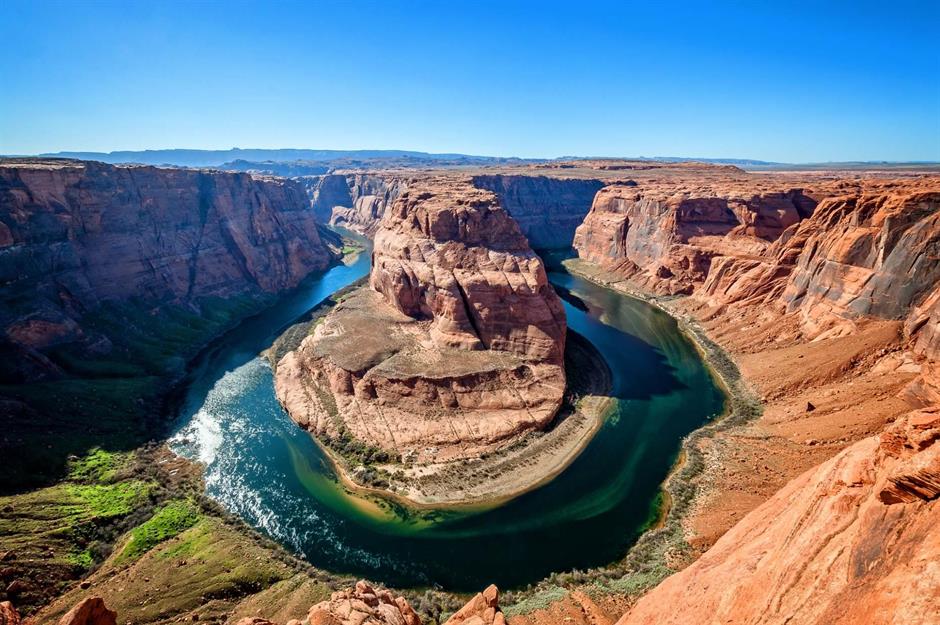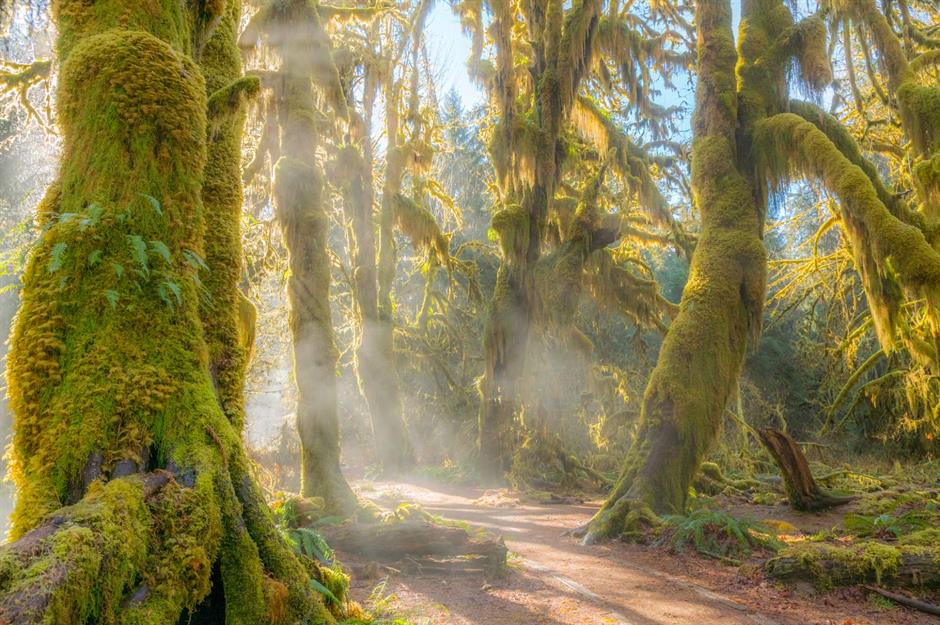Ranked: America’s most beautiful landscapes
Stunning scenery all over the US
30. Hoh Rain Forest, Olympic Peninsula, Washington
Washington’s Olympic National Park is home to some of the largest swathes of old-growth forest in the country and Hoh Rain Forest is easily the most gorgeous. In this temperate rainforest, moss-covered maples, cedars and fir trees spread their branches like mighty claws, creating a lush green canopy punctured only by atmospheric mists. It’s home to a variety of wildlife too, from Roosevelt elk to black bears, bobcats and mountain lions.
29. Chicago skyline, Chicago, Illinois
The twinkling lights of downtown Chicago, seen here from across the shores of Lake Michigan, make the Windy City look all the more inviting at dusk. Famous high-rises include Willis Tower, one of the world’s tallest buildings at a colossal 1,450 feet (442m); the historic Tribune Tower, a Neo-Gothic skyscraper completed in 1925; and the 1,136-foot (346m) Aon Center, formerly the tallest marble-clad building in the world.
Love this? Follow us on Facebook for more travel inspiration
28. Hamilton Pool Preserve, Dripping Springs, Texas
With its vibrant emerald waters, fed by a 50-foot (15m) waterfall which cascades off a curved limestone canyon, Hamilton Pool Preserve is one of the most scenic swimming spots in the US. Located around 30 miles (48km) west of Austin, the watering hole was formed by the collapse of a dome above an underground river thousands of years ago. Sadly, however, it has recently been closed to swimmers for the foreseeable future, due to the risk of falling rocks. It’s still mesmerising to look at though.
27. Seattle skyline, Seattle, Washington
26. Florida Keys, Florida
In this eye-catching aerial shot, Florida Keys’ tiny islets look almost like an intricate jigsaw puzzle, sliced apart by dazzling azure seas. The island chain extends for some 125 miles (201km), but the most popular islands of Islamorada, Key Largo and Key West draw in most of the visitors. The surrounding ocean, a designated National Marine Sanctuary, is home to tropical fish, as well as whales, dolphins and manatees.
25. White Mountains, New Hampshire/Maine
24. Turnip Rock, Port Austin, Michigan
23. French Quarter, New Orleans, Louisiana
The historic buildings of NOLA’s French Quarter come to life at night, when they’re illuminated in rainbow colours by neon lights. And it’s this fusion of old and new that makes the district so enticing. Founded in 1718, its original wooden buildings were built when New Orleans was under French control, but were largely burned in a fire in 1788. The cast-iron balconies, walled courtyards and colourful façades we see today date to the late 18th and 19th centuries, and are a mix of French, Spanish, American and Creole influences.
22. Sequoia National Park, California
The majestic Sequoia National Park in the southern Sierra Nevada mountain range is a land of superlatives. Its most famous tree, the towering General Sherman, is the largest known tree on earth by volume at 52,508 cubic feet (1,487m3), plus it’s a towering 275-feet (83m) tall. What’s more, it’s thought to be some 2,300 to 2,700 years-old. As well as being extremely old and extremely large, the park’s namesake trees are incredibly beautiful, thanks to their distinctive reddish bark and ruler-straight trunks.
21. Big Sur, California
Big Sur is about as legendary as road trips get. This 90-mile (145km) stretch of road, between Carmel-by-the-Sea and Hearst Castle along California's Central Coast, takes in one jaw-dropping view after the next. Think rugged coastlines flanked by crashing waves, sheltered coves encircled by seabirds and historic lighthouses dotting the cliffs.
Take a look at our guide to planning a Central Coast road trip
20. Great Smoky Mountains, Tennessee/North Carolina
Harbouring more biodiversity than any other national park in the US – there are more than 19,000 documented species here, but an additional 80,000–100,000 are thought to exist – the Great Smokies is pretty special. The UNESCO-recognised park, which encompasses an area of more than 800 square miles (2,072sq km) on the border between Tennessee and North Carolina, is also home to some of the oldest mountains on Earth. Oh, and it’s breathtaking to look at too, its hulking mountains filled with flowers and wildlife.
19. Central Park, New York City, New York
Designed by renowned landscape architects Frederick Law Olmsted and Calvert Vaux, the gargantuan 843-acre Central Park was built in the latter half of the 19th century. It set the bar for city parks back then and still does today. Containing everything from a zoo to an Alice in Wonderland statue, along with lakes, bridges and wooded areas, the park has rightfully earned a reputation as one of the country’s most stunning urban green spaces. In winter, when it’s dusted in snow and the famous Wollman Rink opens to skaters, it takes on an extra kind of magic.
18. Mendenhall Glacier, Juneau, Alaska
There’s something startling about the turquoise, electric blue and emerald hues that are conjured up as the light hits Mendenhall Glacier. Situated around 13 miles (21km) from Juneau in southeastern Alaska, this 12-mile (19km) long, 1.5-mile (2.4km) wide glacier can be viewed from inside its “ice caves” during a tour. Or, for those who don’t enjoy the idea of walking through narrow tunnels below an enormous block of ice, gazing at it from the outside is equally impressive – it’s one of North America's most accessible glaciers.
17. Great Sand Dunes National Park and Preserve, Colorado
16. Everglades, Florida
15. Glacier National Park, Montana
14. Nā Pali Coast, Kauai, Hawaii
13. Yosemite National Park, California
Vertiginous granite peaks, awe-inspiring waterfalls and clearer-than-clear freshwater lakes are just some of the many treasures to be found in Yosemite National Park. This 1,189 square-mile (3,080sq km) region in east-central California became America’s third national park in 1890 and today it’s one of the most popular, usually attracting around four million visitors a year. Pictured are El Capitan (left), an enormous dome rising 3,600 feet (1,100m) above the valley floor, and Bridalveil Fall, which cascades for some 620 feet (189m).
12. Kenai Fjords National Park, Alaska
11. White Sands National Park, New Mexico
There’s a real sense of being at the end of the Earth at White Sands National Park, situated in the Tularosa Basin of southeastern New Mexico. Here, paper-white, wind-carved sand dunes stretch as far as the eye can see – in fact, it’s the largest gypsum dunefield in the world at 275 square miles (712sq km). The spectacular sand dunes, which range in elevation from 3,890 to 4,116 feet (1,186 to 1,255m), are best viewed at sunrise or sunset when they’re awash with bluish light.
10. Monument Valley Navajo Tribal Park, Arizona/Utah
9. Badlands National Park, South Dakota
8. Lake Tahoe, California/Nevada
7. The Palouse, Washington/Idaho
The long-underrated Palouse is finally beginning to get the attention it deserves for its breathtaking beauty. The farming region, which spreads across southeast Washington and north-central Idaho, is known for its rolling fields which turn golden and yellow during the autumn harvest season, and lush green in spring and summer. These captivating hills were formed over tens of thousands of years, from wind-blown dust and silt from dryer climes, creating the gently undulating landscape we see today.
6. Bonneville Salt Flats, Utah
5. Maroon Bells, Colorado
4. Antelope Canyon, Arizona
From every angle, Antelope Canyon is totally mesmerising, with its rippling sandstone walls taking on myriad organic forms. Situated within the Navajo Nation reserve in northern Arizona, the narrow slot canyon is just eight to 12 feet (2.4–3.7m) wide in places, making for a dramatic array of colours as the light beams into it at different times of day. It was formed by flash flooding, which eroded away at the bedrock over thousands of years, and whipping winds, which hurled sand at the canyon walls and created the swirling shapes we see today.
3. Grand Prismatic Spring, Yellowstone National Park, Wyoming
At 370 feet (113m) in diameter, Yellowstone’s Grand Prismatic Spring is America’s largest hot spring and the third largest in the world. Its ultra-vivid colours, which might look like the result of some serious photo editing, are actually formed by bacteria. In the centre, it’s too hot for almost any bacteria to survive, so the water appears clear and blue due to the scattering of blue wavelengths (the same effect that makes the ocean look blue). But as the water spreads outwards it cools down and can foster different types of bacteria, which produce the green and yellow bands on the outside.
2. Horseshoe Bend, Arizona
The aptly-named Horseshoe Bend looks almost as if a giant horseshoe has been embossed into the Earth. This gorgeous canyon, located near Page, actually owes its distinctive U-shaped curve to the meandering course of the Colorado River, which carved it out over millions of years. It’s no wonder the ultra-photogenic spot has proven such a hit with visitors – it’s just five miles (8km) downstream of Glen Canyon Dam and Lake Powell too.
1. Bryce Canyon National Park, Utah
An abundance of rock chimneys fill several natural amphitheatres which comprise Bryce Canyon National Park. Located in southwestern Utah, the unique canyon is home to the largest collection of hoodoos (spindly rock towers) in the world, which are especially dazzling as the early morning sunlight hits the canyon. Or, for that matter, when they’re coated in a light dusting of snow in winter. The national park has a difference in elevation of more than 2,000 feet (610m), meaning it has three different climate zones which are home to a rich array of wildlife and plants.
Check out the best things to see in America's national parks

